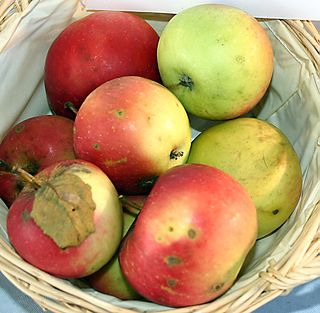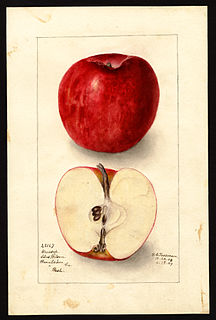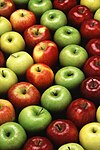
Pollination of fruit trees is required to produce seeds with surrounding fruit. It is the process of moving pollen from the anther to the stigma, either in the same flower or in another flower. Some tree species, including many fruit trees, do not produce fruit from self-pollination, so pollinizer trees are planted in orchards.

Swale is a local government district with borough status in Kent, England and is bounded by Medway to the west, Canterbury to the east, Ashford to the south and Maidstone to the south west. Its council is based in Sittingbourne. The district is named after the narrow channel called The Swale, that separates the mainland of Kent from the Isle of Sheppey, and which occupies the central part of the district.

Cider apples are a group of apple cultivars grown for their use in the production of cider. Cider apples are distinguished from "cookers" and "eaters", or dessert apples, by their bitterness or dryness of flavour, qualities which make the fruit unpalatable but can be useful in cidermaking. Some apples are considered to occupy more than one category.

Brogdale is a hamlet in Kent, England, immediately south of the M2 motorway, 2 miles (3.2 km) south of Faversham. It is one of several hamlets making up the civil parish of Ospringe and is in the Borough of Swale. Its western half is in the Kent Downs Area of Outstanding Natural Beauty.

A cooking apple or culinary apple is an apple that is used primarily for cooking, as opposed to a dessert apple, which is eaten raw. Cooking apples are generally larger, and can be tarter than dessert varieties. Some varieties have a firm flesh that does not break down much when cooked. Culinary varieties with a high acid content produce froth when cooked, which is desirable for some recipes. Britain grows a large range of apples specifically for cooking. Worldwide, dual-purpose varieties are more widely grown.

The Flower of Kent is a green cultivar of cooking apple. According to the story, this is the apple Isaac Newton saw falling to ground from its tree, inspiring his laws of universal gravitation. It is pear-shaped, mealy, and sub-acid, and of generally poor quality by today's standards. As its name suggests, this cultivar likely originated from Kent, England.

Gravenstein is a triploid apple cultivar that originated in the 17th century or earlier. The fruit has a tart flavor; in the Northern Hemisphere it is picked in July and August and is heavily used as a cooking apple, especially for apple sauce and apple cider. It does not keep well, and it is available only in season.

The Jonathan apple is a medium-sized sweet apple, with a touch of acid and a tough but smooth skin. It is closely related to the Esopus Spitzenburg apple, good for eating fresh and for cooking. Sugar 14%, acid 9g/litre, vitamin C 5mg/100g.

Winesap is an old apple cultivar of unknown origin, dating at least to American colonial times. Its apples are sweet with a tangy finish. They are used for eating, cooking, are especially prized for cider.

Blenheim Orange is a cultivar of apple. It was found at Woodstock, Oxfordshire near Blenheim in England in about 1740. It has been described as a cooking apple.

The 'Rhode Island Greening' is an American apple variety and the official fruit of the state of Rhode Island.

The Rome apple is a cooking apple originating near Rome Township, Ohio, in the early 19th century. This apple remains popular for its glossy red fruit and for its utility in cooking.

An apple is an edible fruit produced by an apple tree. Apple trees are cultivated worldwide and are the most widely grown species in the genus Malus. The tree originated in Central Asia, where its wild ancestor, Malus sieversii, is still found today. Apples have been grown for thousands of years in Asia and Europe and were brought to North America by European colonists. Apples have religious and mythological significance in many cultures, including Norse, Greek, and European Christian tradition.

'Discovery' is an early season dessert apple cultivar. One of its parents was the 'Worcester Pearmain', with the pollinator thought to possibly be 'Beauty of Bath'.

The 'Laxton's Superb' is an apple cultivar that was developed in England in 1897. It is a cross breed between Cellini and 'Cox's Orange Pippin' and is not a cross between Wyken Pippin and Cox Orange Pippin. It is a British apple with a green color and a dull red flush. It is a firm-textured dessert apple. The fruit is well known for its sweet and aromatic taste which is likened to the parent species it is derived from, the 'Cox's Orange Pippin'. Density 0,82 g/cc, sugar 14,0%, acid 7,4 g/litre. Vitamin C 9mg/100g.

'Beauty of Bath' is a dessert apple cultivar.

White Transparent is an early-season cultivar of apple which is usually used for cooking due to its sharp taste. It is sometimes said to be the same as 'Yellow Transparent', but 'Yellow Transparent' is sometimes described differently, with fine rather than coarse flesh, and a sub-acid rather than acid flavour. Weight 75 g, density 0.75 g/cc, sugar 10.5%, acid 11 g/litre, vitamin C 15 mg/100g.

Liveland Raspberry or Lowland Raspberry is an old cultivar of domesticated apple, first recorded before 1870, that originated from the Livland Governorate of eastern Europe and was introduced into the United States of America in 1883. It is a very early ripening apple.

Dumelow's Seedling is a cultivar of domesticated apple that originated at Shackerstone in Leicestershire where it was grown by Richard Dumeller in 1800. It is known by many other names including 'Dumelow's Crab', 'Wellington', 'Doncklaer', 'Beauty', and 'Belle de Vennes'. The fruit is not ready for harvest until October, being one of the last of the season, and keeps well into the next year. Though inferior for use as a dessert apple it cooks well and in early-20th century England was one of the most valuable varieties of cooking apple.




















